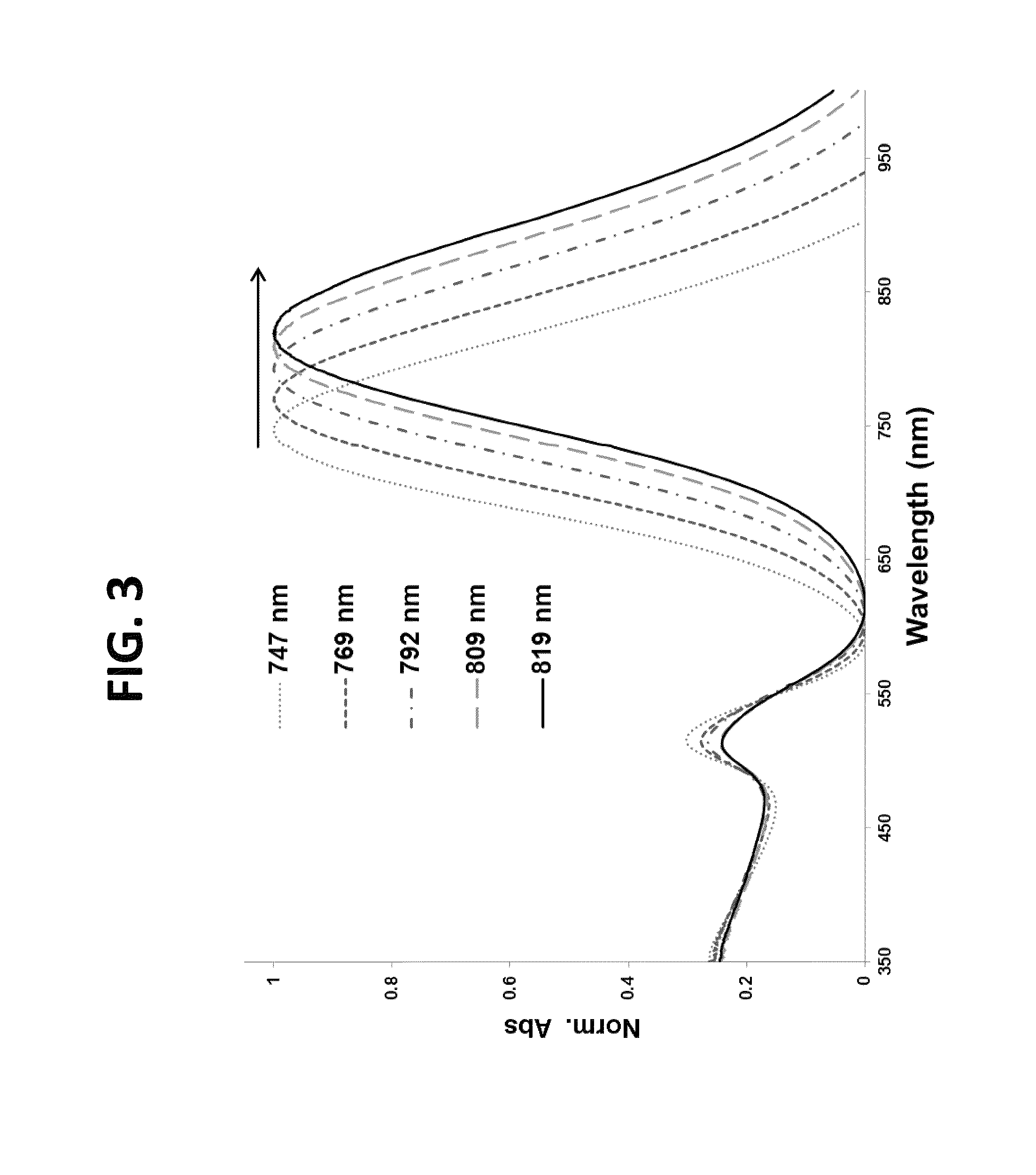Nanothermometer, methods and uses therefor
a technology of nanometers and other materials, applied in the field of nanometers, can solve the problems of increasing fluorescence, unquenching fluorescence of fluorophore, and sub-millimeter temperature measurement, and achieve the effect of increasing fluorescence and avoiding repetition
- Summary
- Abstract
- Description
- Claims
- Application Information
AI Technical Summary
Benefits of technology
Problems solved by technology
Method used
Image
Examples
example 1
[0091]This example illustrates the synthesis of a dye-peptide conjugate of the present teachings.
[0092]The dye-peptide conjugates 1-3 were prepared using a standard solid state peptide synthesis protocol (FIG. 1). Briefly, Fmoc was removed from Rink amide resin with 20% piperidine in DMF with shaking and washed with DMF and DCM. After filtration DMF, Fmoc protected amino acid, DIEA, a solution of coupling reagents HOBT and HBTU in DMF were added. After the reaction was completed, the solvent was removed, and Fmoc was deprotected. The resin was washed, filtered and the next amino acid was added and the procedure repeated. After addition of the final amino acid, coumarin-NHS30 was added to the chain. The product was cleaved from the resin filtered and purified by reverse phase flash chromatography. A representative synthesis of compound 2: Fmoc was removed from 0.58 mmol Rink amide resin (0.10 g, 0.058 mmol loading) with 20% piperidine in DMF 3×10 minutes each with shaking. Deprotecte...
example 2
[0094]This example demonstrates the synthesis of a nanothermometer of the present teachings.
[0095]The overall design of the nanothermometers is shown in FIG. 7. The synthesis of the nanothermometers involved several convergent steps (FIG. 2). First, gold nanorods were prepared via an established procedure using a seed mediated synthesis in the presence of cetyl trimethyl ammonium bromide (CTAB) (See Chen, Y. S., et al., Nano Lett. 11: 348-54, 2011). Briefly, 5 mL of CTAB(aq) solution at 30-35° C. (0.2 M) was first mixed with 5 mL of HAuCl4(aq) solution (0.5 mM) with stirring. Then 0.60 mL of ice-cold NaBH4(aq) solution (0.01 M) was added to the mixture and vigorously stirred for 2 min at 30° C., which resulted in the formation of a brownish yellow seed solution. The growth solution was prepared by adding 0.15-0.2 mL AgNO3(aq) (4 mM) and then 5 mL of HAuCl4(aq) (1 mM) solutions to a 5 mL of CTAB(aq) at 30-35° C. (0.2 M) solution, under gentle mixing, followed by 70 μL of ascorbic aci...
example 3
[0100]This example illustrates evaluation of the synthesized nanothermometers.
[0101]In these experiments, following nanothermometer preparation, peptide-dye conjugates 1-3 were evaluated to determine the effect of i). the number of thiols and ii). the placement of thiols, relative to one another, within the linker. The temperature release profile was recorded for each sample in PBS buffer using two temperature ramps—slow, linear ramp 0.9° C. / min of heating, total 60 min. and fast, non-linear ramp from 20 to 85° C., total 8 min (FIG. 9, FIG. 10) While the first is better suited for kinetic measurements of peptide-dye conjugate release, the latter is more relevant for thermal ablations in clinics. Corresponding data were obtained using a standard fluorescence spectrophotometer with a temperature controlled cuvette holder and by using a thermal ablation imager.
[0102]In these experiments, nanothermometers were dispersed into PBS, pH 7.0 and subject to heating-cooling cycle. For slow tem...
PUM
| Property | Measurement | Unit |
|---|---|---|
| temperature | aaaaa | aaaaa |
| temperature | aaaaa | aaaaa |
| temperature | aaaaa | aaaaa |
Abstract
Description
Claims
Application Information
 Login to View More
Login to View More - R&D
- Intellectual Property
- Life Sciences
- Materials
- Tech Scout
- Unparalleled Data Quality
- Higher Quality Content
- 60% Fewer Hallucinations
Browse by: Latest US Patents, China's latest patents, Technical Efficacy Thesaurus, Application Domain, Technology Topic, Popular Technical Reports.
© 2025 PatSnap. All rights reserved.Legal|Privacy policy|Modern Slavery Act Transparency Statement|Sitemap|About US| Contact US: help@patsnap.com



